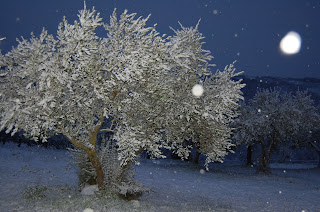 |
| Olives waiting to be pressed at a local frantoio, Umbria |
In the aftermath of the current
olive oil scandal sweeping across Europe, four or five multi-nationals will be
chastised for blending oils from several Mediterranean countries and selling
them as 100% Italian, or, as Extra Virgin when they aren’t. This European network of inter-locking
corporations, defined by La Repubblica, the
Italian newspaper (Dec. 26, 2011) as a cartel and an agro-mafia, will probably
be fined.
 |
| Old olive trees, Puglia |
Consumers across the globe will be left with a bad
taste in their mouths, determined never again to buy Italian extra virgin olive
oil, which has always been thought by many to be the best.
As a result, thousands of small
independent producers, often with families dependent on the annual harvest to
put the next year’s food on the table, will be unfairly tainted, tarred with
the same brush as the mass market suppliers. They may be producing DOP oil (Protected
Designation of Origin, an EU designation), recognized as the best regional
extra virgin olive oil, but they might as well be making the same sorry swill
stocked on the shelves of supermarket chains around the world.
Whose job is it to police the
industry? There are regulations in place in the European Union and fraud units
assigned to the daunting task of finding the cheats in the olive oil trade. The U.S. passed regulations about olive
oil categories in 2010, but they are voluntary. Nobody has enough inspectors.
It’s the perfect situation for fraud.
So, what is the consumer who
loves olive oil to do?
TTPPT: Taste Trust Price
Producer Travel
Taste. Educate your palate, just as you would
if you were buying wine. There are plenty of alternatives to mass-market olive
oil. Specialized olive oil stores have opened around the world and many offer
customers the opportunity to taste the oil before they buy it. Look for the freshest oil. Don’t go for
the clear bottles, which don’t protect the oil from spoilage as well as dark
glass or tins. Use your oil in a few months and store it in a dark, cool spot.
Trust. Find a specialty shop that sells oil and develop a
relationship with the owner or buyer.
Ask them to set up a tasting of several oils or set one up yourself.
(See how the professionals do it by downloading Olive Oil IQ to your smartphone or tablet).
Price. You get what you pay for, just like when
buying wine. You may come upon a jug wine or a mass produced olive oil that’s
pretty good, but if you want DOP extra virgin olive oil, or a bottle of DOCG
vino, you will have to pay more than 5 Euros or 5 pounds or 5 dollars for it if
you want a product that has been picked and pressed by a local producer in the
traditional way.
Producer. Find the producers whose oil you
like and ask your local shop to let you know when the new oil arrives. Every
year will be slightly different, depending on the harvest conditions, but eventually you will
recognize a group of labels that offer the oil you want.
Travel. If you’ve followed the wine
routes, think about traveling the olive oil routes. All across the
Mediterranean, from Italy to Spain to France to Greece, as well as in the New
World, there are places to taste and buy local extra virgin olive oil. Often wineries will also produce oil,
so check the websites of the wines you like. Make the experience a part of a
culinary vacation, as way of educating yourself to know what good oil tastes
like, as well as to experience the ambience that is an essential part of a
local olive oil culture.
copyright Sharri Whiting 2012








